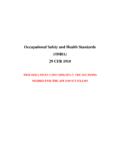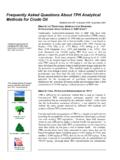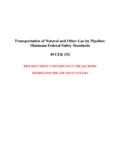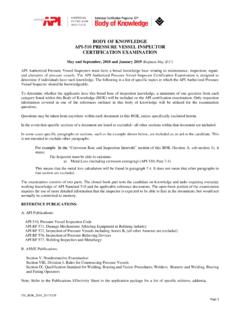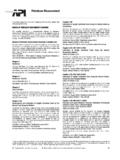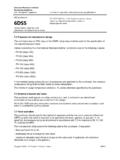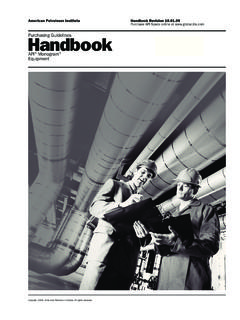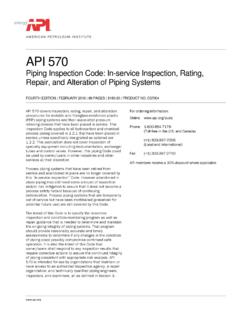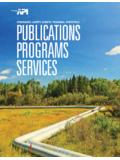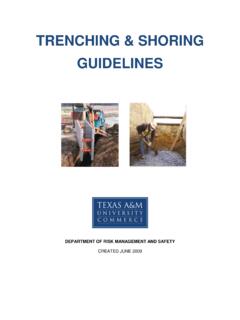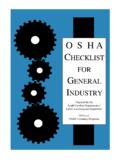Transcription of 29 CFR 1926 Safety and Health Regulations for Construction
1 Safety and Health Regulations for Construction (OSHA) 29 CFR 1926 THIS DOCUMENT CONTAINS ONLY THE SECTIONS NEEDED FOR THE API 1169 ICP EXAMS Sections Subpart C General Safety and Health Provisions General Safety and Health provisions. Safety training and education. First aid and medical attention. Fire protection and prevention. Housekeeping. Illumination. Sanitation. Personal protective equipment. Acceptable certifications. Shipbuilding and ship repairing. Definitions. Access to employee exposure and medical records. Means of egress . Employee emergency action plans. Subpart D Occupational Health and Environmental Controls Lead. Subpart E Personal Protective and Life Saving Equipment Eye and face protection. Subpart F Fire Protection and Prevention Flammable liquids. Subpart H Materials Handling, Storage, Use, and Disposal General requirements for storage. Rigging equipment for material handling.
2 Subpart L Scaffolds General requirements. Subpart M Fall Protection Scope, application, and definitions applicable to this subpart. Duty to have fall protection. Subpart O Motor Vehicles, Mechanized Equipment, and Marine Operations Motor vehicles. Subpart P Excavations Scope, application, and definitions applicable to this subpart. Specific excavation requirements. Requirements for protective systems. Appendix A to Subpart P of Part 1926 Soil Classification Appendix B to Subpart P of Part 1926 Sloping and Benching Appendix C to Subpart P of Part 1926 Timber Shoring for Trenches Appendix D to Subpart P of Part 1926 Aluminum Hydraulic Shoring for Trenches Appendix E to Subpart P of Part 1926 Alternatives to Timber Shoring Appendix F to Subpart P of Part 1926 Selection of Protective Systems Subpart U Blasting and the Use of Explosives Surface transportation of explosives. Definitions applicable to this subpart. Subpart CC Cranes and Derricks in Construction Operation.
3 29 CFR 1926 (OSHA) 1 Subpart C General Safety and Health Provisions AUTHORITY: 40 3701 et seq.; 29 653, 655, 657; Secretary of Labor's Order No. 12-71 (36 FR 8754), 8-76 (41 FR 25059), 9-83 (48 FR 35736), 6-96 (62 FR 111), 5-2007 (72 FR 31160), or 1-2012 (77 FR 3912) as applicable; and 29 CFR part 1911. General Safety and Health provisions. (a) Contractor requirements. (1) Section 107 of the Act requires that it shall be a condition of each contract which is entered into under legislation subject to Reorganization Plan Number 14 of 1950 (64 Stat. 1267), as defined in , and is for Construction , alteration, and/or repair, including painting and decorating, that no contractor or subcontractor for any part of the contract work shall require any laborer or mechanic employed in the performance of the contract to work in surroundings or under working conditions which are unsanitary, hazardous, or dangerous to his Health or Safety . (b) Accident prevention responsibilities.
4 (1) It shall be the responsibility of the employer to initiate and maintain such programs as may be necessary to comply with this part. (2) Such programs shall provide for frequent and regular inspections of the job sites, materials, and equipment to be made by competent persons designated by the employers. (3) The use of any machinery, tool, material, or equipment which is not in compliance with any applicable requirement of this part is prohibited. Such machine, tool, material, or equipment shall either be identified as unsafe by tagging or locking the controls to render them inoperable or shall be physically removed from its place of operation. (4) The employer shall permit only those employees qualified by training or experience to operate equipment and machinery. (c) The standards contained in this part shall apply with respect to employments performed in a workplace in a State, the District of Columbia, the Commonwealth of Puerto Rico, the Virgin Islands, American Samoa, Guam, Trust Territory of the Pacific Islands, Wake Island, Outer Continental Shelf lands defined in the Outer Continental Shelf Lands Act, Johnston Island, and the Canal Zone.
5 (d) (1) If a particular standard is specifically applicable to a condition, practice, means, method, operation, or process, it shall prevail over any different general standard which might otherwise be applicable to the same condition, practice, means, method, operation, or process. (2) On the other hand, any standard shall apply according to its terms to any employment and place of employment in any industry, even though particular standards are also prescribed for the industry to the extent that none of such particular standards applies. (e) In the event a standard protects on its face a class of persons larger than employees, the standard shall be applicable under this part only to employees and their employment and places of employment. (f) Compliance duties owed to each employee (1) Personal protective equipment. standards in this part requiring the employer to provide personal protective equipment (PPE), including respirators and other types of PPE, because of hazards to employees impose a separate compliance duty with respect to 29 CFR 1926 (OSHA) 2 each employee covered by the requirement.
6 The employer must provide PPE to each employee required to use the PPE, and each failure to provide PPE to an employee may be considered a separate violation. (2) Training. standards in this part requiring training on hazards and related matters, such as standards requiring that employees receive training or that the employer train employees, provide training to employees, or institute or implement a training program, impose a separate compliance duty with respect to each employee covered by the requirement. The employer must train each affected employee in the manner required by the standard, and each failure to train an employee may be considered a separate violation. [44 FR 8577, Feb. 9, 1979; 44 FR 20940, Apr. 6, 1979, as amended at 58 FR 35078, June 30, 1993; 73 FR 75588, Dec. 12, 2008] Safety training and education. (a) General requirements. The Secretary shall, pursuant to section 107(f) of the Act, establish and supervise programs for the education and training of employers and employees in the recognition, avoidance and prevention of unsafe conditions in employments covered by the act.
7 (b) Employer responsibility. (1) The employer should avail himself of the Safety and Health training programs the Secretary provides. (2) The employer shall instruct each employee in the recognition and avoidance of unsafe conditions and the Regulations applicable to his work environment to control or eliminate any hazards or other exposure to illness or injury. (3) Employees required to handle or use poisons, caustics, and other harmful substances shall be instructed regarding the safe handling and use, and be made aware of the potential hazards, personal hygiene, and personal protective measures required. (4) In job site areas where harmful plants or animals are present, employees who may be exposed shall be instructed regarding the potential hazards, and how to avoid injury, and the first aid procedures to be used in the event of injury. (5) Employees required to handle or use flammable liquids, gases, or toxic materials shall be instructed in the safe handling and use of these materials and made aware of the specific requirements contained in subparts D, F, and other applicable subparts of this part.
8 [44 FR 8577, Feb. 9, 1979; 44 FR 20940, Apr. 6, 1979, as amended at 80 FR 25518, May 4, 2015] Recording and reporting of injuries. [Reserved] First aid and medical attention. First aid services and provisions for medical care shall be made available by the employer for every employee covered by these Regulations . Regulations prescribing specific requirements for first aid, medical attention, and emergency facilities are contained in subpart D of this part. 29 CFR 1926 (OSHA) 3 Fire protection and prevention. The employer shall be responsible for the development and maintenance of an effective fire protection and prevention program at the job site throughout all phases of the Construction , repair, alteration, or demolition work. The employer shall ensure the availability of the fire protection and suppression equipment required by subpart F of this part. Housekeeping. (a) During the course of Construction , alteration, or repairs, form and scrap lumber with protruding nails, and all other debris, shall be kept cleared from work areas, passageways, and stairs, in and around buildings or other structures.
9 (b) Combustible scrap and debris shall be removed at regular intervals during the course of Construction . Safe means shall be provided to facilitate such removal. (c) Containers shall be provided for the collection and separation of waste, trash, oily and used rags, and other refuse. Containers used for garbage and other oily, flammable, or hazardous wastes, such as caustics, acids, harmful dusts, etc. shall be equipped with covers. Garbage and other waste shall be disposed of at frequent and regular intervals. Illumination. Construction areas, aisles, stairs, ramps, runways, corridors, offices, shops, and storage areas where work is in progress shall be lighted with either natural or artificial illumination. The minimum illumination requirements for work areas are contained in subpart D of this part. Sanitation. Health and sanitation requirements for drinking water are contained in subpart D of this part. Personal protective equipment. (a) The employer is responsible for requiring the wearing of appropriate personal protective equipment in all operations where there is an exposure to hazardous conditions or where this part indicates the need for using such equipment to reduce the hazards to the employees.
10 (b) Regulations governing the use, selection, and maintenance of personal protective and lifesaving equipment are described under subpart E of this part. Acceptable certifications. (a) Pressure vessels. Current and valid certification by an insurance company or regulatory authority shall be deemed as acceptable evidence of safe installation, inspection, and testing of pressure vessels provided by the employer. (b) Boilers. Boilers provided by the employer shall be deemed to be in compliance with the requirements of this part when evidence of current and valid certification by an insurance company or regulatory authority attesting to the safe installation, inspection, and testing is presented. 29 CFR 1926 (OSHA) 4 (c) Other requirements. Regulations prescribing specific requirements for other types of pressure vessels and similar equipment are contained in subparts F and O of this part. Shipbuilding and ship repairing. (a) General. Shipbuilding, ship repairing, alterations, and maintenance performed on ships under Government contract, except naval ship Construction , is work subject to the Act.
